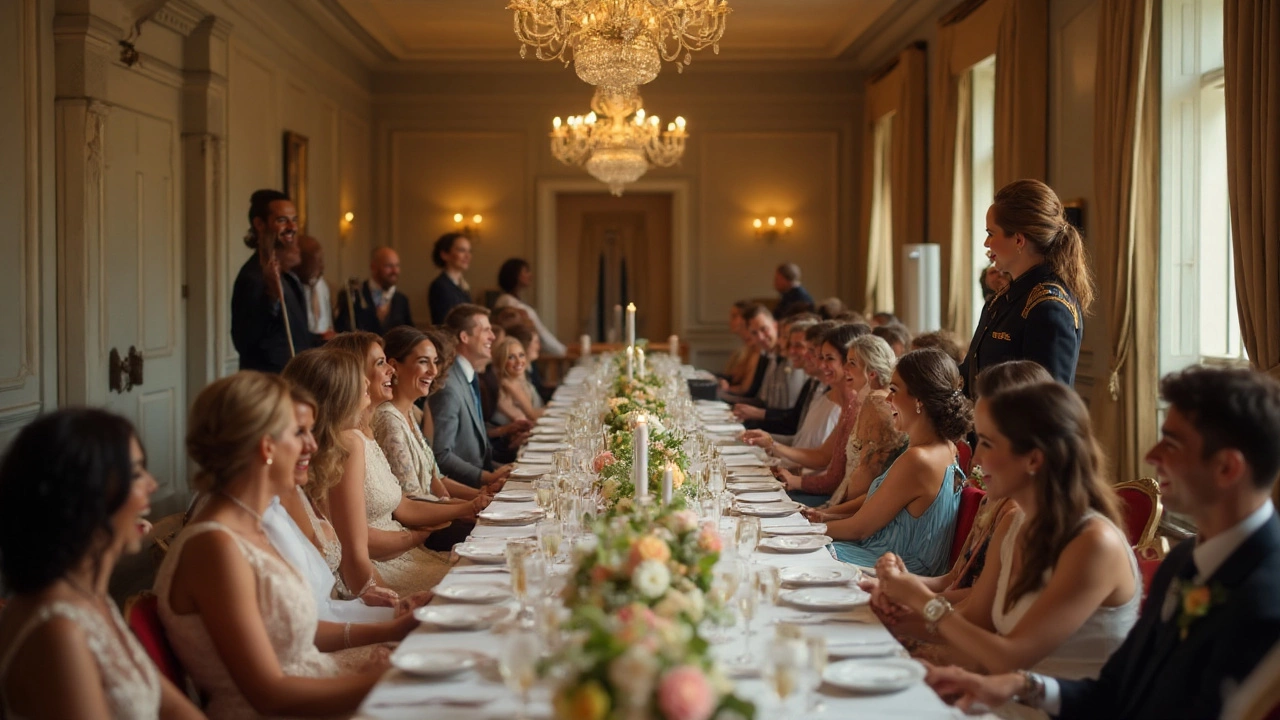Is $30,000 Enough for a Wedding? Real Costs, Tips, and Smarter Planning
 Aug, 6 2025
Aug, 6 2025
Picture this: a wedding bill that’s the price of a new car, a year’s rent, or that round-the-world adventure you keep on your vision board. Now, when you spot a couple budgeting $30,000 for their wedding, is that a sensible number or a total splurge? Could you pull off a memorable, beautiful day on a budget that size? Or are you in for a reality check the minute you call a venue? Let’s strip away the romance for a second and talk practical, concrete numbers, what $30k can really buy you in 2025, and whether that price tag makes your dreams come true or leaves you hungry and cranky on your own big day.
The Real Costs: What $30,000 Actually Covers in 2025
Think $30,000 is a big chunk of change? It totally is—but what does it actually get you at today's prices? In the U.S., the typical wedding lands somewhere between $28,000 and $35,000, according to The Knot’s 2024 Real Weddings Study. That $30k slots you right in the average range. But drill down a bit and you’ll see that it goes much faster than you might guess.
If your guest list hovers around 100 to 120 people, the biggest slice by far is your venue—often about 35-40% of the total. Plenty of venues now charge $10,000–$12,000 just for the space, and usually, that’s not even with food included. If you want on-site catering, add another $100–$150 per guest, quickly snowballing into another $12,000 or so. Most couples planning a $30,000 wedding find that, between the space and the food, they’ve spent 70% of their budget and haven’t even talked dress, music, or flowers yet.
This is the point where sticker shock hits hard. Take photography—a must-have if you want more than blurry iPhone memories. Well-regarded photographers can easily charge $3,500 to $7,000 for a full day. Florals? A mid-range package covering bouquets, centerpieces, and a modest ceremony arch can eat up another $2,500 to $4,000. Factor in your DJ or band (think $1,200–$4,000), attire for the couple ($2,000 to $5,000 for dress and suit), invitations, cake, and basic décor...your $30k is almost gone. Add in the “surprise” costs like tips, taxes, vendor travel fees, or overtime, and you’ll wonder how anyone manages not to blow past their budget.
Where you tie the knot matters, too. If you’re thinking Manhattan, the Bay Area, or Miami—brace yourself. In top-tier cities, prices are often higher across the board, and $30,000 starts to feel like a shoestring budget. But shift to a rural spot, a small town, or even a Friday or Sunday celebration, and your dollars stretch much further. Off-peak or non-traditional venues (community halls, local parks, backyard weddings) help your $30k cover a lot more ground, especially if you’re willing to swap a black-tie ballroom for something unique and intimate.
One wild card: inflation. Floral suppliers keep mentioning how supply chain issues and climate changes push up the costs every year, so what worked for last year’s couple might cost you 10–15% more this season. So, if you’ve been hoarding Pinterest boards and following TikTok wedding trends, remember that each year adds to your total, sometimes quietly and sometimes not-so-subtly.
Breaking Down the Budget: Where People Splurge or Save
Wonder why your friend swears she pulled off a dreamy wedding on $25,000, while another pal needed $50,000 for a similar guest count? The key lies in your must-haves and your willingness to flex. Let’s dissect where most couples splurge and where the savers get creative.
Food and drink easily eat up the most cash, so if you want to wow with a five-course foodie feast and open bar, expect to devote 45–50% of your $30,000 right there. But swap a plated dinner for a family-style meal, brunch, or food trucks, and you could cut that portion down by 20–30%. Some couples ditch the formal sit-down altogether for cocktail receptions with heavy hors d’oeuvres—and nobody seems to mind, as long as portions are hearty and the drinks keep flowing.
Photography is another area where couples face a tough choice: save on the day and risk basic pictures, or invest in someone who’ll make you look stunning and catch little moments you’ll actually want to display. The sweet spot seems to be around $4,000 for an experienced professional in a mid-sized city, but this shoots up in metro areas, where elites can charge twice that. Savvy couples sometimes compromise with an up-and-coming photographer who’s just starting their full-time business—lots of talent, often for much less.
Music—one of those pieces people never regret spending on. Sure, Spotify and a friend with a playlist can do the trick, but there’s a different energy when a live band or pro DJ keeps things moving and fills awkward silences. A live band eats at your budget most, so if you can’t splurge, grab an experienced DJ who can read the room and keep your dance floor going all night.
Florals and décor are a trickier balancing act. If you want your ceremony bursting with flowers, expect prices to soar. Some couples, though, go for minimalist greenery, skip extra centerpieces, or even do a lot of the decorating themselves. Rental décor companies offering modern arches and tableware can turn a basic space into something Insta-worthy for less than you’d pay to buy everything outright. If you must have that wild floral installation or custom lighting, just know it steals budget from other categories.
Then, there are the unglamorous but crucial costs—transportation, hair and makeup, marriage license, and insurance. These often get overlooked during initial planning, but when left out, they can bust the budget later. Smart couples make room for these non-negotiables, even if it means a little less splash elsewhere.
An underrated way to save? The guest list. Every extra person brings another plate, another chair, another invitation. Cutting even ten guests can save you over $1,200 at the average per-head rate. Couples who keep their celebrations tight—think 60-80 people—get the biggest bang for their buck.

Smart Planning: Tips to Make ,000 Work for You
Let’s be honest—nobody wants to start married life with credit card debt just from their wedding. Making $30,000 work is all about setting clear priorities and making intentional choices early. Here’s how couples maximize their budgets while still having a celebration that feels special.
- Decide your non-negotiables up front. What matters most—is it an unforgettable meal, a killer party vibe, or photos you’ll love forever? Spend more in a couple areas, and scale back elsewhere without guilt.
- Shrink the guest list if possible. Every invite snowballs into higher costs for food, rentals, invites, seats, and even larger venues. Smaller weddings almost always mean more time and better experiences with your guests, too.
- Use non-traditional venues. Parks, libraries, warehouses, and family backyards can save thousands over hotel ballrooms. Sometimes, all a space needs is a few creative touches to shine.
- Go off-peak. Getting married in January or February—or hosting a Friday or Sunday event—often brings major venue discounts and vendors with more wiggle room.
- DIY… but not too much. Some details are fun to make yourself but can quickly become overwhelming. Pick one area (maybe your signage, simple florals, or favors) and buy the rest.
- Research package deals or all-in-one venues. Some venues offer packages bundling food, drinks, tables, and coordination, which can be cheaper and smoother than assembling everything a la carte.
- Rethink traditions. If a thousand-dollar cake isn’t your thing, swap for donuts, cupcakes, or even an ice cream bar.
- Watch out for hidden fees. Always read contracts for overtime, add-ons, and required vendors. Those $500 “administration” charges sneak up fast.
- Lean on talented friends and family—musicians, florists, bakers—if they want to gift their skills. Just remember, it’s only helpful if they truly want to pitch in, not out of obligation.
- Create a detailed spreadsheet and update it weekly. Weddings always cost more than you expect; track every deposit, tip, and tax to avoid surprises.
One more pro tip: Build a buffer into your budget. Set aside $1,500–$2,000 for last-minute “gotchas” (weather backup tents, extra shuttles, or vendor tips). Nearly every couple I know needed this buffer in the end and were glad they had it.
Is $30,000 Worth It? The Emotional and Practical Value
Here’s the big question: does spending $30,000 on one day make sense? There’s no single answer—it’s about what feels right for you as a couple, and whether it matches your bigger life goals. For some, it’s the best day ever, a true celebration worth every penny. For others, the idea of tying up so much cash in one day feels off, especially with housing, student loans, or travel goals on the line.
Real talk: you absolutely can throw a stunning wedding for $30,000 in 2025 if you’re focused and practical. Couples who walk away happiest usually say they put their dollars into what felt most personal to them, whether that was food, party, or the memories captured forever in photos and video. Many also say they sacrificed certain "expected" details—like extravagant programs, favors, or unnecessary upgrades—so their money could flow toward a few meaningful splurges.
On the flip side, couples who regret their spend usually point to outside pressures—parents, friends, or social media—pushing them to add more guests, trendier décor, or expensive traditions that didn’t feel authentic. If you’re not careful, those extra “little” things are what pushes your $30,000 to $40,000 or beyond…quickly. It helps to set clear boundaries with anyone helping financially, and to remember that most guests remember the food, dancing, and overall vibe, not much else.
Let’s not forget the alternatives either. Couples sometimes take a portion of that $30,000—say, $15,000—and elope somewhere meaningful, then throw an epic party later, or use the money for a down payment. There’s no wrong choice, just the one that fits your life best.
Finally, don’t let comparison steal your joy. Social media weddings are often sponsored or staged—and rarely reflect what real couples actually spend. Your celebration, whether it costs $5,000 or $100,000, is special because it's yours. Wedding budget isn’t a competition, and the truest mark of success is how you feel at the end of the night, surrounded by people you care about, doing things that matter to you. If $30,000 lets you build that memory—with no “wedding hangover” in your bank account—then you’ve absolutely nailed it.